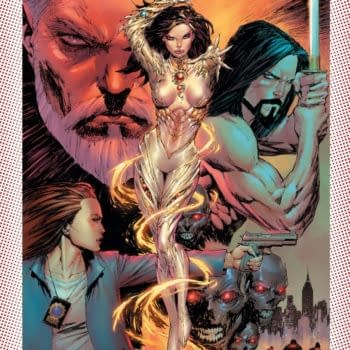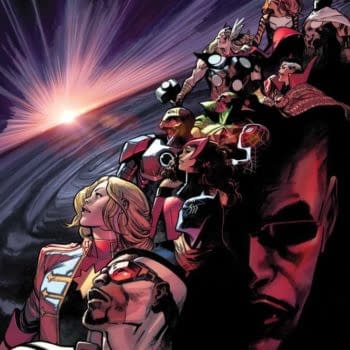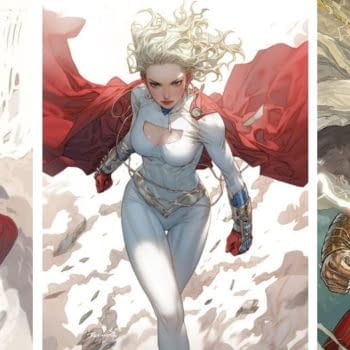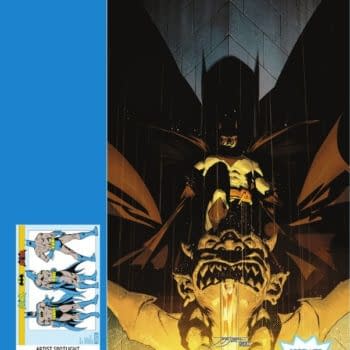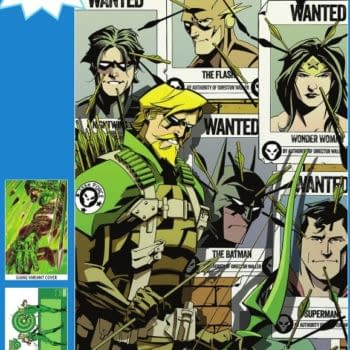Posted in: Comics | Tagged: Comics, dc, frank quitely, grant morrison, marvel
Jack Of All Trades by Dave Wallace: The Essential Morrison & Quitely
Dave Wallace writes for Bleeding Cool;

Let me know if you agree with my rankings…
6. Earth 2
For many readers, this JLA story would probably come higher up the list of Morrison & Quitely favourites. It's certainly a great showcase for Quitely's art, giving him the chance to illustrate most of DC's leading superheroes whilst also having some fun with their evil alternate-universe counterparts. However, for all of the colourful, imaginative fun and vivid superhero action that the story provides, it's also probably the least innovative and least dense of the creators' collaborations.
Nevertheless, it's still well worth checking out, whether in its original graphic-novel form or as collected in the fourth volume of the more recent deluxe hardcover collections of Morrison's JLA run.
Somewhere out there in the infinity of parallel-universes is a world in which Frank Quitely illustrated each and every issue of Grant Morrison's run on New X-Men. In that parallel world, this list would probably place their run on the mutant superhero title a lot higher up than fifth place.
Yet despite the many fill-in artists that would later come to characterise the New X-Men saga (with some artists faring better than others), the early Quitely-illustrated issues of this book were fantastic superhero comics. Morrison's conceptual update of the X-Men franchise provided a solid in-story reason for Quitely to give the characters a new look that made them feel fresh and modern for the first time in years, whilst the artist also coped admirably with huge-scale ideas like the decimation of Genosha early on in Morrison's run.
It's telling that the highest peaks of Morrison's run coincided with those issues that Quitely was able to illustrate — notably the artist's all-too-brief return for the "Riot at Xavier's" storyline, in which Quentin Quire established himself as a significant X-Men villain and Xorn got a whole lot more interesting.
Quitely's issues are available in the first few TPBs of Morrison's run, and you can also find them in the gargantuan hardcover New X-Men Omnibus which is due to be reprinted later this year.
As the most recent of Quitely's collaborations with Morrison, the first arc of Batman and Robin shows just how good comics can be when the writer and artist are in tune with each other.
Fight scenes are perfectly paced, using snippets of dialogue to create rhythms that reinforce the artistic progression of staccato freeze-frames; sound effects are integrated seamlessly into the artwork, using physical objects present in the scenes to spell out the onomatopoeia; and each frozen panel represents precisely the most meaningful and representative split-second moment of that section of story, creating memorable series-defining images such as Dick and Damian's double-punch of an airborne Mr Toad.
Not only did these first three issues of Batman and Robin succeed in convincing the audience that a non-Bruce-Wayne Batman book could work, but they also set the tone for the rest of the hugely enjoyable title, with Quitely's continuing covers for the rest of Morrison's run often outshining the work of the interior artists.
Aside from those covers (and the brief few pages Quitely contributed to Batman #700 — collected in the "Time and the Batman" volume) all of the artist's work on Morrison's Batman run can be found in the first Batman and Robin TPB collection, "Batman Reborn".
3. The Invisibles
Although only collaborating together on a single issue of Morrison's defining masterpiece, The Invisibles, the fact that it was the final chapter of the saga gave Quitely's work here extra resonance. Set during the final moments of the current phase of Earth's evolution — sometime later this year, in fact — the climactic story draws together most of the big ideas and themes of the series into a dense, memorable and mind-blowing finale.
The story is available in the seventh and final TPB collection of the series, "The Invisible Kingdom" — or, if you can wait until later this year, in DC's gigantic Invisibles omnibus.
If anyone ever claims that comics have run out of ideas and can't do anything innovative any more, point them in the direction of We3. Over the course of three short issues, Morrison and Quitely take a simple story about three mistreated animals trying to find their way home, and turn it into something that packs an unexpectedly emotional as well as intellectual punch.
Applying new methods of depicting time and space that occasionally threatened to exceed the confines of the printed page, the creators' experimental "3-D comics" approach to the book was its major selling point — even moreso than the heartstrings-tugging nature of the tale about a cat, a dog and a rabbit that had been used and abused as part of a military experiment.
To say any more would be to spoil the book for those (few) of you who haven't read it yet, but if you haven't ever had the pleasure then you've got a choice: either buy the regular TPB or the new "deluxe" hardcover (which features a few new pages that aren't essential — and which in one place actually interrupt the flow of the original story — but which are nice to have nonetheless).
A predictable favourite, but a favourite nonetheless: All-Star Superman is the culmination of all of Morrison and Quitely's years of working together: the quintessential Superman story that draws on all eras of the character's rich history to create an elegant, imaginative twelve-issue epic about the last days of Superman's life.
Taking the "all-star" of the title as a cue, Morrison structures the entire 12-issue story around a single 24-hour cycle of the Sun's Earth, with the emotional lows (Pa Kent's death; Bizarro world) coinciding with the midnight that comes at the middle of the book, and the high points (Superman's spaceship rescue; that final image of him in the heart of the sun) bookending the story with the star at his highest points.
So much has been written about the strengths of this series in the past that I hardly need repeat it, but suffice it to say that it's the fusion of Morrison's dense, efficient writing and Quitely's characterful, imagination-defying artwork that make this series such a special thing. I can heartily recommend the Absolute edition of the book for the most beautiful presentation of the story, but it's freely available in TPB and regular-sized HC too.
OK, time for a round-up of my picks of this week's new releases.
New Release Round-Up:
Black Orchid, deluxe edition HC: Shamefully, Black Orchid is one of the few comics by Neil Gaiman that I still haven't read. I plan to remedy that with the release of this deluxe hardcover edition, which presents the three-issue miniseries in its entirety, in one of DC's tidy slightly-oversized volumes. Given that this is the series that made Gaiman's name in American comics — leading most notably to the birth of the Sandman title, another adult reinvention of an existing DC property — it's worth a look for its historical importance alone. But the fact that the book also features painted art by Dave McKean means it's bound to be a beautiful-looking (as well as beautifully-written) package. My pick of the week.
Batman: Knightfall volume 1 TPB: This new edition of "Knightfall" has doubtless been released in order to coincide with Bane's appearance in the upcoming Dark Knight Rises movie. So is it worth shelling out for given that you can probably pick up a second-hand copy of an earlier printing for half the price? Well, like the recent "No Man's Land" reprintings, this volume apparently features some sections of the story that have never been reprinted, so if you're a completist (and we're comics fans, so that's a pretty safe bet), this might be the edition you need to look out for. It collects "Batman: Vengeance of Bane", as well as Batman #491-500, Detective Comics #659-660, Showcase '93 #7-8 and Batman: Shadow of the Bat #17-18.

Chew volume 5 TPB: Major League: Bloody hell, it feels like Chew only launched yesterday, and it's already up to its fifth TPB volume! As with the rapidly-expanding hordes of Walking Dead and Invincible TPBs, it serves as another reminder of just how emphatically Image Comics has put its weight behind solid creator-owned projects, and why the publisher is enjoying such a resurgence in popularity these days. Collects issues #21-25.
Reviews:
Flex Mentallo HC: It's been a long, long wait for Grant Morrison and Frank Quitely's first collaboration to be reprinted in a collected edition — but if any book is worth waiting for, it's this one.

Whilst most BleedingCool readers will have probably found a way to read the series in recent years — whether legally in the now-expensive single issues, or via more nefarious methods — there are still a lot of reasons to recommend picking this fancy hardcover edition up. For one thing, Quitely's art looks fantastic in the format, with many of the pages rescanned from the original art boards, giving them added clarity and precision (and it really shows — some of these pages look as though they could have been produced yesterday). There's also a fair bit of extra material, including plenty of pencilled/inked pages, production sketches, and the metatextual prose columns that ran in issues #2 and #4 of the original miniseries,
My only real reservation about this collection is the revised colouring, about which I feel ambivalent. The artwork certainly gains a lot more subtlety through Peter Doherty's colour changes, with some nuanced grading effects and gentler tones that completely change the feel of some of the pages. But therein lies my problem with the book, too: many of the bolder, more vivid colour choices of the original have been eviscerated here, giving us a Mentallium man who is dull gunmetal grey instead of fluorescent yellow, and a row of tumbledown cottages that share the same dull stone colour rather than the psychedelic pinks and yellows of the original.
My disappointment with some of these choices is tempered by the fact that the recolouring job has apparently been done in close conjunction with the original creators, and reflects their intentions more closely than the original issues did. But at the same time, I liked some of those more garish choices in the original printing, and I'm sad to lose them here.
In the end, I feel much the same about it as I did about the recently-recoloured Killing Joke deluxe hardcover: it doesn't spoil the story by any means, but it does subtly alter the feeling of some of the scenes, and I wish that DC would give us the choice of buying the Flex miniseries as originally presented, as well as this recoloured version.
(Oh, and for those wondering where this book would come in my Morrison/Quitely list — it'd be a very close second to All-Star Superman. But only just.)

It's worth reading if only for Chuck Dixon and Graham Nolan's original one-shot, which crafts a detailed and compelling backstory for Bane, setting him up as both the physical and intellectual equal of Batman in a manner that I hope Chris Nolan has managed to capture in the character's (second) movie incarnation. The issue also features some lovely visuals, in a style that feels like the last hurrah of good, solid, semi-realistic 1980s artwork, before things took an exaggerated and "extreme" turn in the following decade.
Which brings us to the four issues of "Bane of the Demon", which make up the majority of this TPB. Set long after "Vengeance" — as well as some time after the "Knightfall" event in which Bane really made his mark as a character — "Bane of the Demon" pairs him with Talia Al Ghul in an adventure that initially sets Bane up to uncover both the truth behind his parentage and the secrets of an ancient conspiratorial religious sect.
But having set up that Mamma Mia!-meets-The Da Vinci Code-esque concept, those elements get completely thrown by the wayside as Bane instead gets involved in a convoluted plot that revolves around a biological weapon being sought by the League of Assassins.
All of which wouldn't be so bad if the story actually led anywhere — but instead it feels as though it puts a lot of elements in place and sets up a lot of interesting character relationships, only to suddenly end abruptly, just as things are beginning to get interesting.
This is an unfortunate consequence of the fact that "Bane of the Demon" was a lead-in series to the larger "Legacy" event which ran throughout the batbooks — but given that, I can't help but wonder why DC thought it was a good story to include in a book which is being marketed to fans who want to bone up on the character before this summer's big Batman movie.
Why not include the Bane comics that the character is really famous for (you know, like the one where he broke Batman's back) rather than some secondary tale that only makes a passing reference to that milestone for the character (and which only features the tiniest of cameo appearances from Batman himself)?
I can only assume that the story collected here bears more relevance to the story of The Dark Knight Rises than we currently realise, and thus the book will seem more meaningful once we've seen the movie. Given the presence of Talia Al Ghul, Ra's Al Ghul, the League of Assassins and a biological terrorist threat on Gotham in this story, I guess it's not too much of a stretch to think that Nolan may have adapted the "Legacy" storyline for his film, at least in part.
Still, even then it wouldn't resolve the main problem that this TPB contains just one great issue that's unfortunately padded-out with a four-issue miniseries that doesn't really go anywhere and doesn't really tell us a whole lot about the title character. If I were you, I'd see if I can get my hands on the "Vengeance of Bane" one-shot some other way instead.
To Be Continued…
Next time, I'm going to expand on my discussion of the changes made to Flex Mentallo in its collected edition by looking at a lot of other stories that were altered before being reprinted in TPB or HC form. Whether it's minor dialogue changes or full-scale art replacement, I want to look at the advantages and disadvantages of creators being given another pass at a story before it's collected. So if you have any thoughts on the subject, let me have them in the thread below!










